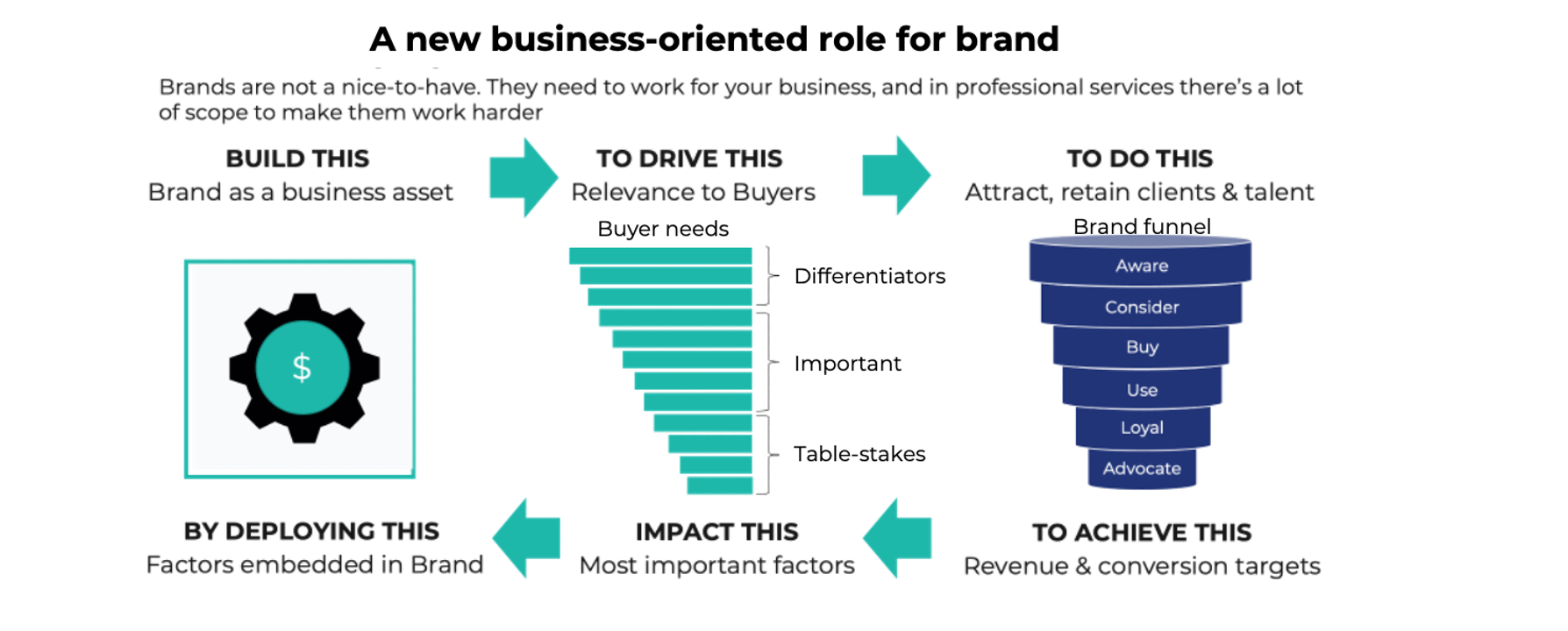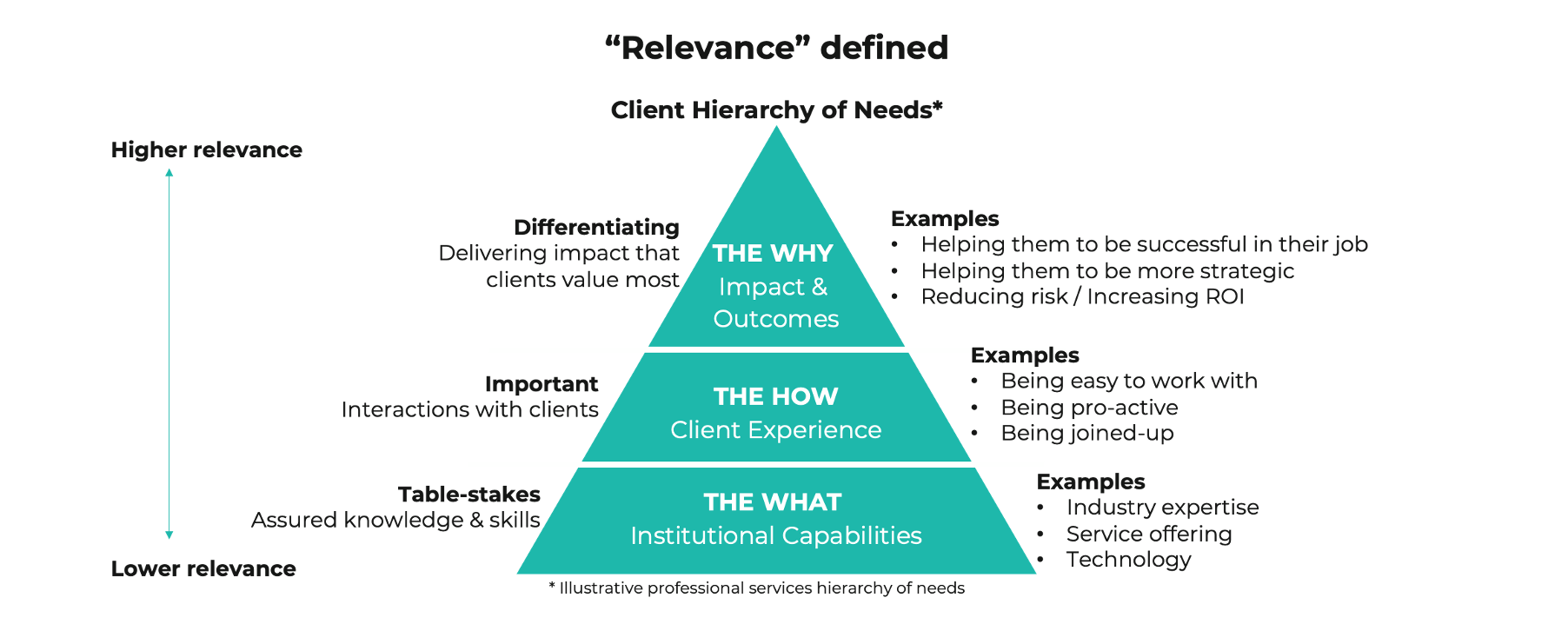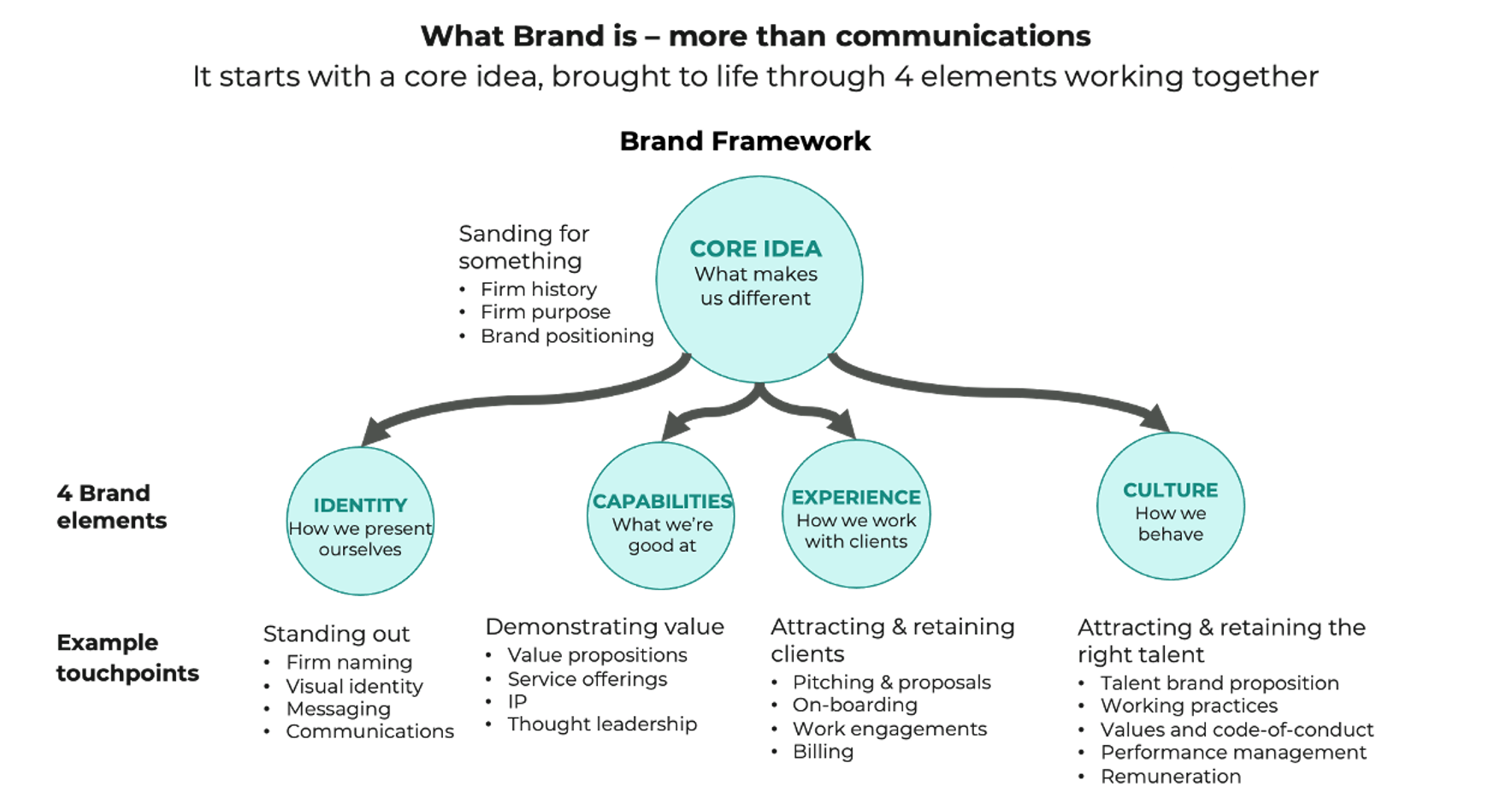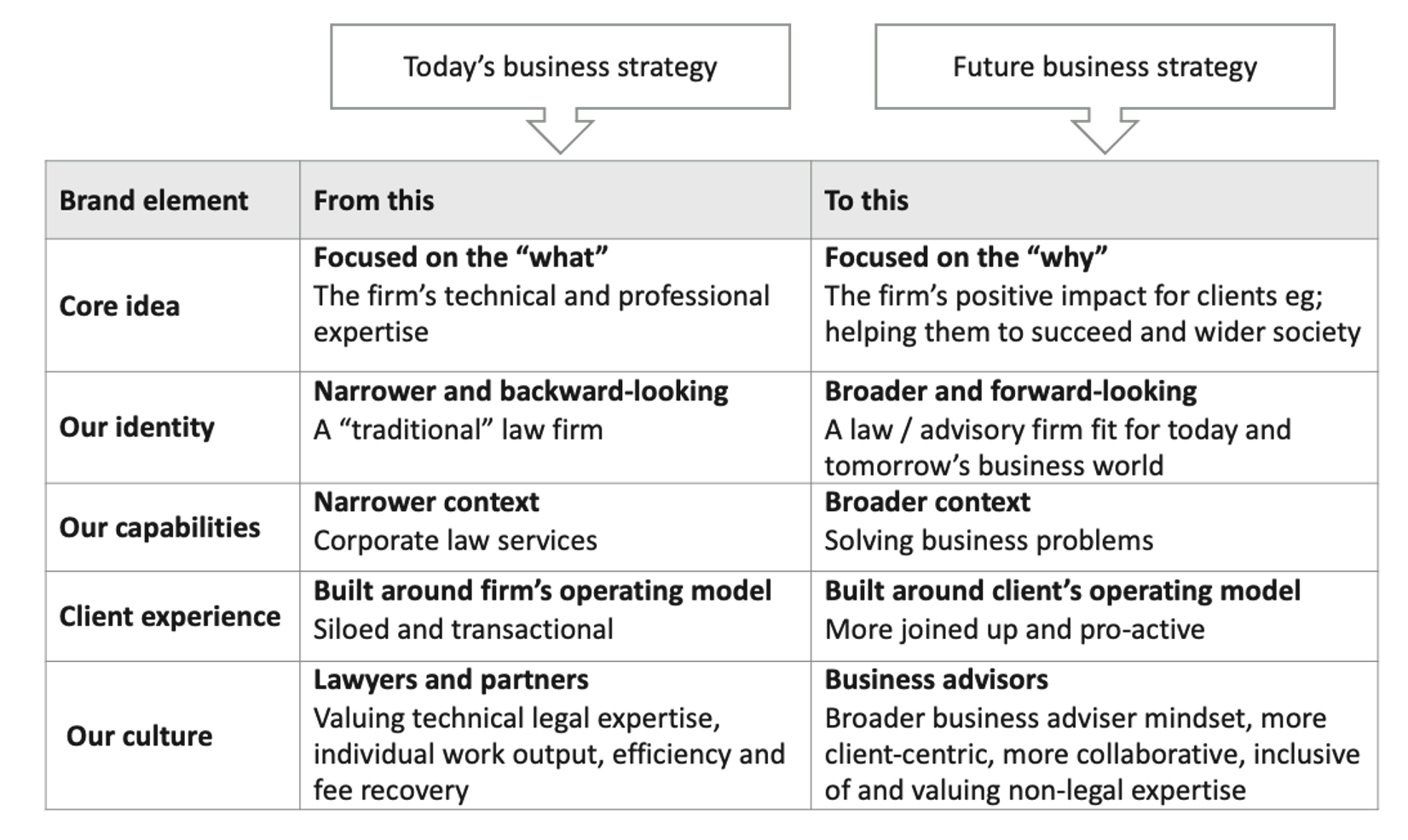By Ian Duncan, B2B Brand Strategy
INTRODUCTION
Marketing people often cite law firms as one of the last holdouts in valuing marketing or brand. Some of this is an outdated stereotype. Many law firms now employ marketing directors and put a lot of effort into lead generation to build a pipeline of new clients. Some have improved their branding, shortening their firm’s name, updating their logo and websites. However, given the major changes taking place in the legal services industry, and their impact on “traditional” corporate law firms, now is the time to leverage Brand in a bigger and more strategic way to sustain growth into the future. This paper outlines the why, what, and how of what that means.
WHY BRAND IS RELEVANT NOW – THE BUSINESS CONTEXT
Organizations typically look to external brand experts when they’re having trouble dealing with change, have exhausted the actions they can think of and are “stuck.” This is particularly the case when the pressures they’re feeling are driven by changes in the buying behavior of their clients. Recent data on buyers and sellers of legal services highlights the pressures on law firms’ business:
- 55% of in-house legal teams state that they have reviewed or intend to review their existing legal service providers
- 52% say they are likely to consider using non-traditional law firms
- Over 60% of law firms say that other service provers are a potential threat or taking their business now, mainly ALSPs, non-traditional law firms, and the Big 4
- 68% of law firms say that in-sourcing is taking business from them now, with a further 26% seeing this as a potential threat
- 29% of law firms say that client use of technology is reducing the need for lawyers and paralegals with a further 57% seeing this as a potential threat
For those running a now apparently, and unhelpfully, labeled “traditional” corporate law firm, this threat of substitution and lost business must make for uneasy reading. Some will take comfort in the return to healthy market growth rates post-pandemic, forecast at around 4%. Some may cite positive satisfaction / NPS scores as evidence that business is not at risk from clients switching providers. Whatever the source of comfort today, this data is hard to ignore and suggests that “business-as-usual” is not an option for the future.
The heart of the problem – Unmet Customer Needs
The root causes of the growing substitution threat are the changing and unmet needs of buyers of corporate legal services. When a gap opens up between what clients want and what they get from their current providers it leaves a “vacuum” for someone else – in this case, in-house teams, ALSPs, New Law, and the Big 4 – to fill. Unmet needs don’t just appear out of nowhere overnight. They’re the product of changes in the business environment that are reshaping the buyer’s world and job. In legal services, this trend has been accelerated by the application of technology.
My reading of what’s happening is this. Doing business these days is increasingly complex as a result of trends we’re all familiar with – globalization, digital technology, regulation, and rapid innovation. As a result, there’s more legal work required to help businesses operate. While this makes the in-house legal function ever more integral to business success, it also increases its workload in a “do more with less” corporate environment. So, clients are looking for solutions to “make my life easier” and “help me and my team to be more successful”. Technology has a big role in addressing these needs, but it is not enough. Buyers of corporate legal services also highlight the expertise and ways of working they increasingly need from providers, but which they do not see major law firms delivering today (see below).
| Unmet needs | |
| Expertise – want more | Way of working – want more |
| · industry, commercial or non-legal expertise
· Digital, cyber security, and data privacy savvy |
· Pro-active knowledge-sharing across jurisdictions
· Integration between legal practice areas |
In-house teams want a broader range of expertise because the issues they’re tackling are more complex, multi-dimensional, and require a greater degree of business knowledge. They need law firms to deliver a more “joined-up” way of working to help in-house teams do their job of “connecting the dots” and make their life easier.
In this context, positive client NPS scores may not be all they seem. No one wants to deliver “bad news”. In professional services client surveys often focus on table-stakes”, and let’s be honest, the client feels “obliged” to “be nice” to their firm contact. So, firms get a rosy picture that may not reflect underlying changes in client sentiment and masks dissatisfaction about important but unmet needs. Even if this has not yet translated into lost revenue, there are “trapped clients” just waiting for the opportunity to switch providers.
WHAT TO USE BRAND FOR – RECAPTURING AND MONETIZING RELEVANCE
Despite the adoption of marketing by many firms, the corporate Brand is underleveraged in professional services. The problem starts with how “Brand” is defined – typically narrowly as “logo,” “website,” or “advertising” – which demotes it to a marginal role in the firm. But if brand is defined differently and more broadly, it can be a major catalyst in the rethinking and remaking of firms, which the wholesale changes in the industry require.
The change challenge facing traditional corporate law firms is a more fundamental and strategic one of recapturing and maintaining relevance against the backdrop of a changing industry. Relevance means being perceived by buyers of corporate legal services. As the data show, traditional law firms are starting to lose this relevance.
Here’s a way of thinking that connects the dots between Brand, relevance, and business results. “Brand” is defined as the sum total of all interactions between the firm and the market. Brand has the power to attract prospective clients and drive them up the purchase funnel from awareness to advocacy.

The objective is to monetize relevance. The Brand should focus interactions on addressing what’s most important to buyers when they’re choosing a provider. The cornerstone is to understand and statistically quantify the most important factors influencing the buyer’s choice of legal providers i.e., what’s most relevant to them. This provides a powerful “algorithm” that tells firms what to focus on in their interactions with the market.
You will need to invest some money in independent research to quantify what’s most important to buyers, but here’s a simplified framework from my accounting and consulting services research as a starting point.

The industry norm is to focus on capabilities, but these are regarded as table-stakes – not unimportant, just an expected entry requirement. Common assumptions made by firms are that things like “industry expertise” and “technical quality” are what’s most important. Not so. When statistically measured among buyers of accounting and consulting services, “industry expertise” does not even make the shortlist. Their view is that “they can’t know more about my industry than me, what’s valuable are relevant insights from other industries”
Clients often see little difference between firms in what they do – their technical capabilities. Instead, they look at the how and why – how firms work with them and what they get out of it both as individuals and for their enterprise. What clients care about most is how a firm can make their life easier, help them demonstrate greater impact in their organization, and enhance their careers. Most professional services firms just don’t think in those terms and therefore don’t operate in that way. For future Gen Z clients and staff, the why is even more important and more ethically driven.
So, instead of just rattling off a list of service offerings and technical features (with some new areas of expertise added), the law firm proposition for the future needs to prioritize how you work with clients and how you generate the impact and outcomes they care about.
To secure sustainable growth, traditional law firms need transformational, not incremental change. They must re-think their role for buyers (going from the what to the why) and then re-invent themselves to fulfill that role. Firms need to move four “big rocks” to successfully complete that journey:
- Break away from being type-cast as simply another “traditional” law firm while the new kids on the block (so-called “New Law” and ALSPs) garner all the attention and reset client expectations. Standing out against the 40,000 corporate law firms and 1.3 million attorneys in the US requires a singular and coherent message.
- Be seen by clients (in-house legal teams) to bring more of the added value they’re looking for to do their job successfully – more of that commercial, industry, and digital-world expertise
- Adapt how they work with clients and evolve the siloed professional services partnership operating model
- Change the firm’s culture to make (i), (ii), and (iii) possible – reset the mindset from “lawyer” to “business adviser”, facilitate internal collaboration, and potentially accommodate a wider range of (non-legal) skills and expertise
Moving these big rocks will take time and effort. The challenge for a firm’s leadership is to synchronize the inside reality (firm’s resources, culture, growth ambition) with the outside market reality (client needs, competitive threats). Brand comes into its own as a catalyst to enable this ambition and transformation journey to move with momentum.
HOW TO BUILD A BRAND THAT CAN TRANSFORM YOUR BUSINESS
We’ve established what Brand needs to do (direct market interactions to monetize relevance) and why (changing client needs, market disruption, transformational change, moving 4 big rocks). Now we need to define what brand is (in a way that breaks the “brand = communications” way of thinking), and determine how to build a transformational brand.
Our Brand Framework has 5 elements – a “core idea”, plus the 4 elements that bring it to life to shape client interactions and monetize relevance. The factors driving a buyer’s choice of a firm must be the starting point for brand development.

It is critical that the core idea and the 4 elements work together as a coherent whole, all driving in the same direction. Here’s a description of each:
- Core idea – stand out by standing for something: This is a singular idea that defines who you are and captures what makes your firm genuinely different. It has a real practical application that should help you to win more business and recruit top talent. For business transformation, it provides a “North Star” to bring the future ambition to life and mobilize the enterprise.
The core idea must stand for what’s most relevant—not be all about the firm itself, but rather about how it makes the client’s jobs, lives, and organizations better. It should address why the firm exists, and the positive impact it aspires to generate for clients, talent, and if possible, the broader society.
It should be future-facing but without neglecting the firm’s heritage and be credible. For example, a corporate law firm might re-think what they do more in terms of “making business work better” rather than simply “providing quality legal advice”.
- Identity – stand out by how you look and how you talk: On its own, visual identity (logo, graphic design, and website) can’t transform the business, but it is an important element. Firms moving away from an “old-fashioned law firm” to “law firm of the future” must look the part. This means a visual identity and website that signal you are future-facing and digital. But it is as much about how you talk as to how you look. In professional services, this means shifting from long copy full of technical jargon to concise, compelling, and impact-focused content.
- Capabilities – stand out by demonstrating value: Professional services firms deliver value but aren’t very good at demonstrating Focusing mostly on your own capabilities leads to a narrow way of thinking about what “value” means and can leave money on the table. Defining “value” in the client’s terms provides an opportunity for a firm to marshal its resources, e.g., whether it is to help clients do more with less, make their job easier, demonstrate greater impact, or elevate their career. It can also identify new “value propositions” for example by combining some of its capabilities in a new way. Use cases are a powerful way of demonstrating this. Being the firm that thinks and communicates about “value” in a more client-centric way will separate you from the pack.
- Experience – what it’s like to work with you: The professional services industry is very transactional, with firms focused on winning and doing work, getting paid for it, and then moving on to the next opportunity. They’re often accused of making the clients fit around the firm’s business model rather than the other way around. In legal services retainers can be a double-edged sword, sometimes masking and exacerbating dissatisfaction and underlying tensions on both sides. The challenge is to look at the client experience more holistically (the client journey) and identify how to deliver what makes the firm different, and how this delivers added value and eliminates pain points. These don’t have to be very big things; it’s often the small human, thoughtful things that make a big difference.
- Culture – how you behave: This is where business transformation can fall flat on its face. Firms will not be successful in business transformation if the way their people behave does not support the direction in which the firm wants to go. The culture change implicit in what we’ve heard from clients includes resetting the mindset from “lawyer” to “business adviser”, facilitating collaboration across the firm, and potentially accommodating a wider range of (non-legal) skills and expertise.
Successful change in professional services happens from the inside out. Brand has an important role to play in winning hearts and minds to mobilize everyone in the firm, with the core idea as a “North Star” guiding behavior so that everything everyone does contributes to achieving the bigger picture of the firm’s ambition. A powerful brand idea inspires and excites internal stakeholders to embrace change – much better than imposing change upon them.
What brand has to do – Bringing it all together
Below is a framework that sums up the job that brand can help accomplish. There will be no “one-size fits all” for how firms chose to execute against this – it will depend on their business strategy.

HOW TO MAKE IT HAPPEN—GETTING STARTED ON YOUR BRAND JOURNEY
Despite there being a strong business case for using Brand in the way I’ve described, gaining permission to do it often starts with changing the internal conversation about the role of Brand in the business. If there’s no acceptance of a business issue in the first place, that may be difficult, so here are some practical things you can do and have worked for me:
- Connect Brand with business: This was the start of my “change the conversation” journey in professional services. It simply involved putting brand in a business context, by showing that the purpose of Brand was to drive the funnel. People got it – the funnel was intuitive to them – and now we were having a business conversation rather than a brand conversation.
- Use measurement as a lever: Getting your hands on data and creating new insights that make the business sit up and take notice will go a long way to getting the conversation on the agenda. Usually, there’s plenty of data lying around (market survey data, client satisfaction, client-base profile, CRM data, market data, competitor data, employee survey data, campus recruitment data) but no one has delved into it or joined-up disparate data sets into a narrative. If you’re able to commission a proprietary survey that includes brand metrics and funnel metrics this will give you a “baseline” for linking brand to business. Demonstrate a “gap” between where the firm is today vs. where people perceive it to be and where it needs to be, and you have the beginnings of a “business case for change”.
- Nail the core brand idea: This must be crystallized before it’s brought to life. To prevent the natural tendency for “idea by committee” which leads to a lot of circular “noodling,” you need to keep it grounded in strategy (the overarching goal of driving and monetizing relevance) and facts (by addressing the factors that are most important to clients, and talent too). It’s best to have one single author pulling it all together from top to bottom. I’ve tried this as a collaborative process, and it just doesn’t work. When the idea is fixed everything else quickly falls into place and people start to get excited about moving on to execution.
- Use the Brand framework: The brand framework has 3 purposes – (i) to reinforce that “Brand” is more than communications, (ii) to provide a roadmap for the scope of change, and (iii) to ensure that change is coherent and driven by a central governing idea. It starts to come to life for people once they can see some of the firm’s touchpoints mapped to each of the components. What you then need to do (ideally as a management team exercise) is to take the insights gleaned from data, together with the firm’s growth ambitions, to describe the current vs. future state of the brand. You should then translate this into a small number of principles that describe the change that needs to happen e.g., “treat our clients as people and our people as clients”. You now have a pretty good foundation for developing a brand strategy inextricably linked to business strategy and on the leadership agenda.
- Responsibilities and momentum: Nothing gets done if no one is responsible. Once you have the framework and principles, you can allocate responsibilities for reimagining each component of the brand in more detail. This is a good way of involving internal stakeholders and getting them “vested” in the change process and outcome. The easiest way is to farm out the core idea and each of the brand components to small working groups, each tasked with identifying the actions which need to happen in particular functions and practices. It’s their job to define what the priorities are. This is an iterative cross-pollinating process.
- Outside help: If you have not gone through this journey before it will be hard to go it alone. Professional services folks respect the views of other outside experts. So, it’s a good idea to partner with an outside expert. Whether an agency or individual consultant, they need to be credible, persuasive, talk the language of brand as a business strategy, have done it before, have plenty of current external examples to share, and be able to educate leadership about the potential pitfalls and must-dos.
A FINAL THOUGHT
There’s a quote about change that goes something like this
“There are three types of people in this world. Those who make things happen, those who watch things happen, and those who wonder what happened”.
You will find those three types of organizations in any industry undergoing disruptive change, and legal services are no different. There are different ways of responding. M&A is one. Digital is another. But what works is taking action to build better and more profitable relationships with clients and talent. It’s a battle for relevance, and Brand is a key asset to winning that battle. Better to use Brand now to make things happen, rather than leave it until all other avenues have been exhausted and the challenge is too big for Brand to tackle.
ABOUT THE AUTHOR
Ian Duncan
| Ian brings extensive experience of Marketing and Brand leadership roles in professional and financial services firms, including PwC, Mazars, Bank of America and Grant Thornton. Throughout his career he has applied a strategic Marketing / Brand mindset to business transformation, successfully mobilizing organizations in the direction of client-centric and outcome-driven change. |
|
